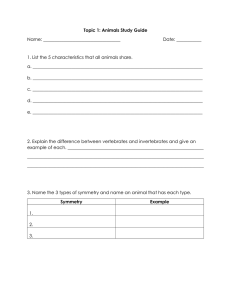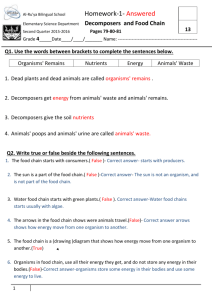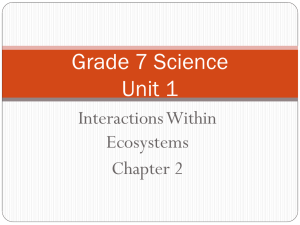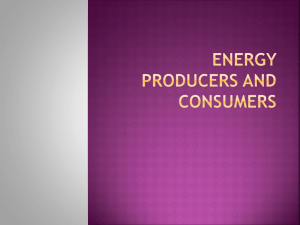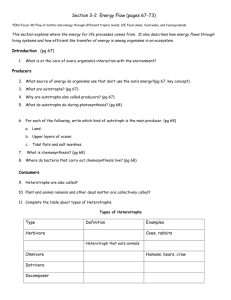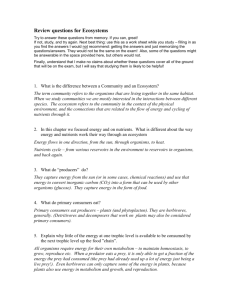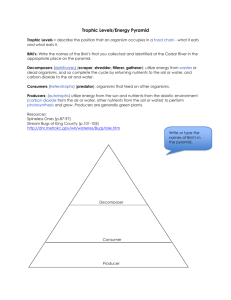abiotic
advertisement
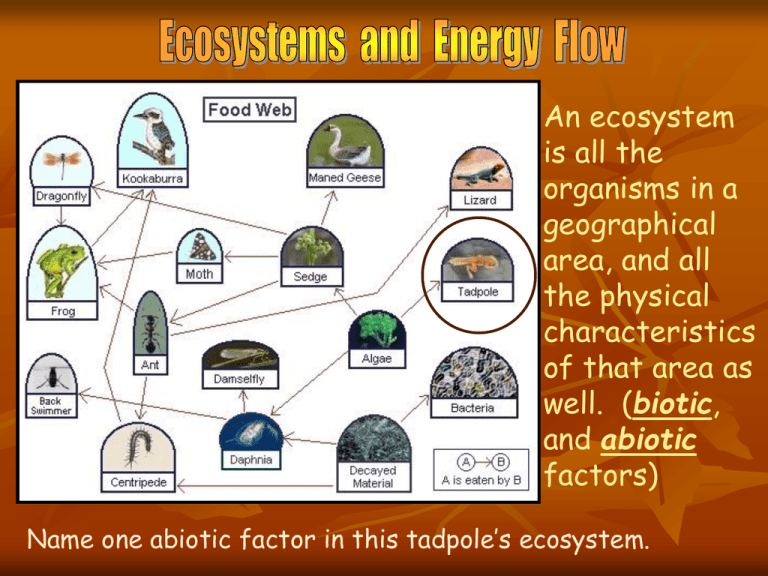
An ecosystem is all the organisms in a geographical area, and all the physical characteristics of that area as well. (biotic, and abiotic factors) Name one abiotic factor in this tadpole’s ecosystem. 1. Producers 2. Consumers 3. Decomposers Producers are also known as autotrophs Organisms that make their own food through photosynthesis and chemosynthesis Photoautotroph/Chemoautotroph 2. Consumers Also known as heterotrophs Organisms that rely on other organisms as food sources to get energy 3. Decomposers Some consume dead organisms and their waste, producing detritus. Some consume detritus, and are called detritivores. Many are microorganisms, but some are multicellular. Organisms that use chemicals to make their own food are called… What is detritus? What is the ultimate source of energy for most organisms on Earth? What is the scientific name given to consumers? Herbivores Eat producers only. Omnivores Eat producers, herbivores, carnivores, and other omnivores Carnivores Eat only other animals Scavengers Do not eat living prey, but instead find dead organisms that have been preyed upon by other carnivorous consumers. Facultative Heterotrophs Carnivorous plants can produce the carbohydrates they need through photosynthesis…but they typically live in bogs, where the soil is very wet, and nutrients, like nitrogen get washed away. They consume insects and even small vertebrates to obtain the required nitrogen. What is the difference between a scavenger and a decomposer? Why have some plants adapted to become facultative heterotrophs? In what biomes might you find facultative heterotrophs? All energy on Earth comes ultimately from the sun. A model of energy flow in ecosystems is called a food web. It shows how matter and energy moves from producers to consumers, and finally to decomposers. Please note, the arrow points to the consumer in any food chain, or web! Decomposers are very easy to accommodate, as they will fit into any trophic level. A trophic level is one step, or link in a food chain. This food web contains many food chains. Do not confuse trophic level, with consumer level! The second trophic level is filled by the primary consumer…the third trophic level is filled by the secondary consumer…etc. When describing a food chain, you always begin with an autotroph… or a producer. Since they are the first trophic level, they are often referred to as primary producers. The second trophic level is filled by the primary consumers…and they are consumed by the secondary consumers, who are consumed by the tertiary consumers, who are consumed by the quaternary consumers…if there is any energy left! Energy "flows" through the ecosystem in the form of carboncarbon bonds. When respiration occurs, the carbon-carbon bonds are broken and the carbon is combined with oxygen to form carbon dioxide. This process releases the energy, which is either used by the organism (to move its muscles, digest food, excrete wastes, think, etc.) or the energy may be lost as heat. Note that all energy comes from the sun, and that the ultimate fate of all energy in ecosystems is to be lost as heat. Energy does not recycle!! This follows the 2nd Law of Thermodynamics…or Entropy. The other component shown in the diagram are the inorganic nutrients. They are inorganic because they do not contain carbon-carbon bonds. The movement of the inorganic nutrients is represented by the open arrows. Note that the autotrophs obtain these inorganic nutrients from the inorganic nutrient pool, which is usually the soil or water surrounding the plants or algae. These inorganic nutrients are passed from organism to organism as one organism is consumed by another. Ultimately, all organisms die and become detritus, food for the decomposers. At this stage, the last of the energy is extracted (and lost as heat) and the inorganic nutrients are returned to the soil or water to be taken up again. The inorganic nutrients are recycled, the energy is not. In the flow of energy and inorganic nutrients through the ecosystem, a few generalizations can be made: • The ultimate source of energy (for most ecosystems) is the sun • The ultimate fate of energy in ecosystems is for it to be lost as heat. • Energy and nutrients are passed from organism to organism through the food chain as one organism consumes another. • Decomposers remove the last energy from the remains of organisms. • Inorganic nutrients are cycled, energy is not What is the one exception to this? How does energy flow through ecosystems? (ie How is energy stored?) What process is responsible for “freeing” the energy in these bonds? In what trophic level does the secondary consumer lie? Which law of thermodynamics does the energy in a food chain follow? In Moodle, use this complex Antarctic Food Web, and diagram 3 possible food chains in a flow map. Select chains that go at least to the quaternary consumer.
